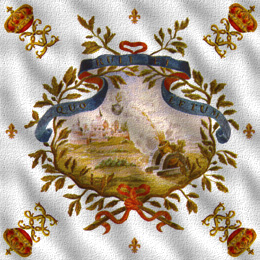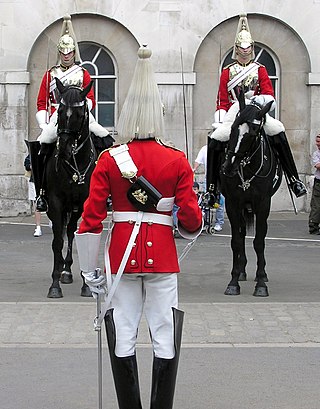
Swiss Guards are Swiss soldiers who have served as guards at foreign European courts since the late 15th century.

The Maison du Roi was the royal household of the King of France. It comprised the military, domestic, and religious entourage of the French royal family during the Ancien Régime and Bourbon Restoration.

A royal guard is a group of military bodyguards, soldiers or armed retainers responsible for the protection of a royal family member, such as a king or queen, or prince or princess. They often are an elite unit of the regular armed forces, or are designated as such, and may maintain special rights or privileges.

Louis-Sébastien Mercier was a French dramatist and writer, whose 1771 novel L'An 2440 is an example of proto-science fiction.

The Great Officers of the Crown of France were the most important officers of state in the French royal court during the Ancien Régime and Bourbon Restoration. They were appointed by the King of France, with all but the Keeper of the Seals being appointments for life. These positions were neither transmissible nor hereditary.

The French Guards were an elite infantry regiment of the French Royal Army. They formed a constituent part of the maison militaire du roi de France under the Ancien Régime.

The Gardes du Corps du Roi was the senior formation of the King of France's household cavalry within the maison militaire du roi de France.
A Colonel General was an officer of the French army during the Ancien Régime, the French Revolution, the Napoleonic era and the Bourbon Restoration.

The Musketeers of the military household of the King of France, also known as the Musketeers of the Guard or King's Musketeers, were an elite fighting company of the military branch of the Maison du Roi, the royal household of the French monarchy.

The Scottish Guards was a bodyguard unit founded in 1418 by the Valois Charles VII of France, to be personal bodyguards to the French monarchy. They were assimilated into the Maison du Roi and later formed the first company of the Garde du Corps du Roi.

Thomas-François de Treil de Pardailhan was the eldest of an ennobled Languedocien family, originating in the Saint-Pons-de-Thomières region. At first an officer in the Maison Militaire du Roi, baron Thomas de Treil de Pardailhan was Maître d'hôtel du Roi at the Court of Versailles at the end of the Ancien Régime. His writings, however, show him as an opponent of the privileges of aristocracy and in favor of the new ideas. The French Revolution marks a rupture with his milieu: in support of deep social reform, he was elected député for Paris in 1791 to the Legislative Assembly, but always remained attached to the idea of a constitutional monarchy and was imprisoned as a suspect during the Reign of Terror. Ruined by bad business dealings under the Directory and by sources of income he had lost in the Revolution, he ended his life at his château at Pardailhan in 1822.

The Constitutional Guard was a French royal guard formation which lasted a few months in 1792 as part of the Maison du Roi, being superseded by the National Guard. It existed in the period of the constitutional monarchy during the French Revolution.

Antoine Jean Galiot Mandat, known as the Marquis de Mandat, was a French nobleman, general and politician. A knight and lord of Berny-en-Santerre and Les Pins in the Vendômois, he became a colonel in the Gardes-Françaises, then succeeded La Fayette as commander of the National Guard in 1792. He was assassinated by insurgents in the insurrection of 10 August during the French Revolution.

The maison militaire du roi de France, in English the military household of the king of France, was the military part of the French royal household or Maison du Roi under the Ancien Régime. The term only appeared in 1671, though such a gathering of units pre-dates this. Like the rest of the royal household, the military household was under the authority of the Secretary of State for the Maison du Roi. Still, it depended on the ordinaire des guerres for its budget. Under Louis XIV, these two officers of state were given joint command of the military household.

The French Royal Army was the principal land force of the Kingdom of France. It served the Bourbon dynasty from the reign of Louis XIV in the mid-17th century to that of Charles X in the 19th, with an interlude from 1792 to 1814 and another during the Hundred Days in 1815. It was permanently dissolved following the July Revolution in 1830. The French Royal Army became a model for the new regimental system that was to be imitated throughout Europe from the mid-17th century onward. It was regarded as Europe's greatest military force for much of its existence.
Jean-Baptiste Alexandre Baron de Strolz, sometimes written Stroltz,, was a French general during the Napoleonic Wars, and subsequently an important political figure.

A life guard is a military unit charged with protecting a high-ranking individual, such as a monarch.
Louis de Roll was a Swiss mercenary active during the French Revolutionary Wars and the Napoleonic Wars.
Jean-François-Madeleine de Gentil was a French officer who participated to the French conquest of Algeria.

The Corps of Observation of the Vendée was a field formation of the French Imperial Army, which took part in the 1815 Vendéen Revolt, one of the minor campaigns of the Hundred Days. Following the end of the War of the Seventh Coalition, the corps was disbanded.





















